Use 'Print preview' to check the number of pages and printer settings.
Print functionality varies between browsers.
Printable page generated Friday, 26 April 2024, 6:19 AM
Non-Communicable Diseases, Emergency Care and Mental Health Module: 18. Prevention and Promotion Activities for Mental Health
Study Session 18 Prevention and Promotion Activities for Mental Health
Introduction
This study session will cover mental health promotion and the primary, secondary and tertiary prevention of mental illness. Mental health promotion and prevention involves (1) educating the community about mental illness; (2) screening for mental illnesses as you conduct your house-to-house visits; (3) telling people about ways that they can reduce their risk of developing a mental illness. Preventive activities for people who already have a mental illness can help to reduce the negative impact of their condition and can reduce the risk of suicide. The response of the community to issues of mental illness can be very important in improving (or making worse) the quality of life experienced by those suffering from mental illness. We conclude this study session by looking at the negative effects of stigma and discrimination, the abuse of mentally ill people, and what you can do to mobilise your community to try to solve these problems.
Learning Outcomes for Study Session 18
When you have studied this session, you should be able to:
18.1 Define and use correctly all of the key words printed in bold. (SAQs 18.1 and SAQ 18.2)
18.2 Explain the basic facts about mental illness to community members. (SAQ 18.1)
18.3 Advise community members on effective ways to reduce their risk of developing mental illness. (SAQ 18.1)
18.4 Screen for mental illness in your community. (SAQ 18.2)
18.5 Describe ways that you can help to reduce the risk of suicide. (SAQ 18.3)
18.6 Draw on community support to challenge stigmatising attitudes, discrimination and abuse. (SAQ 18.4)
18.7 Apply preventative strategies to decrease some of the negative consequences of mental illness. (SAQ 18.4)
18.1 Raising awareness about mental health
Mental illness is often a hidden problem in the community because people don’t know much about mental illness and so they don’t notice it. They may also be frightened by mental illness and ashamed if a family member has symptoms of mental illness, and consequently hide away people who are affected by these problems. One of the most important things that you can do to help people with mental illness is to increase awareness and understanding in the communities where you live and work.
18.1.1 What are we trying to achieve?
By raising awareness about mental health and illness, we are trying to achieve the following goals:
- Mental health promotion and primary prevention. By mental health promotion we mean educating people about ways to improve their mental health. In primary prevention, the aim is to prevent a person from developing a mental illness in the first place. The strategies for improving mental health and avoiding mental illness are similar, so we will group them together.
- Secondary prevention means detecting mental illness as quickly as possible so that the person can receive treatment before the illness progresses.
- Tertiary prevention means trying to reduce some of the negative effects of a mental illness that has already developed.
In the following sections these promotion and prevention activities will be discussed in more detail.
18.2 Mental health promotion and primary prevention
There are four main areas of focus for improving mental health and reducing the risk of mental illness:
- promoting a happy, healthy childhood
- reducing the exposure to violence
- reducing the use of substances such as alcohol, khat and cannabis, and support in coping with life’s problems.
Prevention of intellectual disability is another important area and was covered in Study Session 17.
18.2.1 Promoting a happy, healthy childhood
A child who comes from a loving home is more likely to grow up into an adult who can trust other people, have good relationships and cope with life’s problems (Figure 18.1).
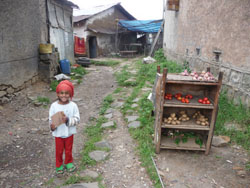
As you learned in Session 17, children who experience physical, emotional or sexual abuse have a much higher risk of developing a mental illness as an adult. Children can also suffer from the effects of bullying. Bullying is when other children say nasty things or are physically violent towards a child.
In Study Session 17 you read about things you can do when you suspect that a child is being abused (Section 17.4.1). Can you now think of some ways that you could
- a.help to prevent child abuse from happening
- b.reduce bullying in your community?
You can
- a.Educate the community about the importance of a happy, healthy childhood, e.g. by holding an awareness-raising meeting (see Section 18.6).
- b.If you have the chance to speak in a school, you can tell the teachers that (1) bullying is common; (2) bullying can lead to mental illness in the child or later when they grow up; (3) it is important to identify when bullying is taking place and do something about it. You can encourage the school to make a plan for dealing with bullying and supporting the child who is bullied.
18.2.2 Reducing exposure to violence
Violence doesn’t just lead to mental health problems in children. Violence can lead to mental illness in adults too.
In Study Session 16 you read about things you can do to help a person who is a victim of violence (Section 16.4). Can you now think of some ways that you could help to prevent violence among adults in your community?
You can
- Educate the community about the negative effects of violence, especially intimate partner violence, on a woman’s mental and physical health.
- Screen pregnant women for violence and the associated mental health problems as part of their antenatal care. Pregnant women are at high risk of being victims of violence.
- Make links with any organisations in your area that work to promote women’s rights or offer support to women who are victims of violence.
- Talk with community elders. As they often play an important role in sorting out marital disputes, you can find out how they handle this situation and encourage them to be tough on violence.
- Make links with local policemen and encourage them to take complaints of violence against women seriously.
18.2.3 Reducing alcohol and khat use
The abuse of drugs, especially alcohol and khat, is often linked to mental illness.
In Study Session 14 you learned about ways to help people who are abusing alcohol or khat. Can you now think of ways that you could help to prevent alcohol and khat abuse in your community?
An effective form of prevention is to educate the community about the effects of excessive alcohol and khat use. For example, you might know somebody in your community who used to have a problem with alcohol or khat but has now stopped using these substances. Ask them to help you spread the message that alcohol and khat can lead to problems for some people, especially when used heavily over an a long period of time.
18.2.4 Coping with life’s problems
Sometimes we face difficulties in life and these can disturb us. We can describe these difficulties as stressful events. Even good things can be considered a stressful event. For example, getting married is a good and positive thing, but preparing for this celebration can put people under a lot of pressure so that it can be a stressful event.
Make a list of all the stressful life events that you can think of.
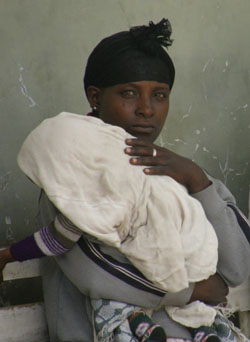 Figure 18.2 Having a baby can be stressful for the mother. (Photo: Basiro Davey)
Figure 18.2 Having a baby can be stressful for the mother. (Photo: Basiro Davey)See Box 18.1 for examples of stressful life events.
Box 18.1 Stressful events
Negative stressful events:
- Somebody close to you dies
- You or somebody you love is very ill or injured
- You lose your job
- You get into conflict with neighbours
- Somebody steals your possessions
- You get into trouble with the police
- The crops fail
- You are separated from your family.
Positive stressful events:
- Getting married
- Having a baby (Figure 18.2).
We all deal with stressful events in different ways.
From your own experience, can you think of some good and bad ways that people might use to cope if somebody they love (e.g. their brother or sister) dies?
Table 18.1 lists some common ways of dealing with problems (coping strategies). They have been divided into ‘helpful’ and ‘unhelpful’ coping strategies. People who use helpful coping strategies are less likely to develop mental illness if they experience a stressful event. Unhelpful coping strategies make the person more likely to develop mental illness.
| Helpful coping strategies | Unhelpful coping strategies |
|---|---|
Spend time with family and friends Talk about your problems Speak to someone with a similar problem Some people find it helpful to pray Exercise Find a way to solve your problem | Drink alcohol heavily Chew khat Stay in bed all day Keep your problems to yourself Avoid dealing with your problems Get into fights |
18.3 Secondary prevention: screening and early treatment
The earlier that a person with mental illness can get treatment, the better their recovery will be. Different types of mental illness can be detected in different ways. In your day-to-day work you can screen people for mental illness. You can also teach the community about detecting mental illness, and encourage them to take the affected person to a health facility.
18.3.1 Screening for specific mental illnesses
Psychosis
In general, this is the easiest type of mental illness to detect because often the person displays very disturbed behaviour. Remind yourself of typical symptoms (Study Session 13). The community will usually recognise people with these symptoms, but most of the time they will not have taken them to the health facility for help.
Depression and anxiety
These forms of mental illness are more difficult to detect. The person with depression is often quiet and withdrawn. They don’t cause a problem for other people and so it is easy to overlook their suffering. (In Study Session 12 you learned some questions that you can ask to screen a person for depression.)
Substance misuse
It may be obvious when a person is drinking too much alcohol, chewing too much khat, or using cannabis, but sometimes the problem is hidden. You should suspect a possible problem with alcohol, khat or cannabis if somebody is always getting into fights, or in trouble with the law, has a lot of accidents, or problems at work. (Some useful questions to screen for these problems were given in Study Session 14.)
18.3.2 Getting early treatment for mental illness
Whenever you have an opportunity, emphasise the benefits of treatment for mental illness. If people do not know that effective treatment exists then they will not make use of the available services.
In Study Session 9 you learned about competing explanatory models for mental illness (see Section 9.2.2). Ask the people in your local community their beliefs about mental illness. Educate people about the causes of mental illness and the available treatment. For example, explain that spirits and witchcraft have nothing to do with mental illness. Patiently listen to their doubts and experiences.
Do not argue with or confront people and always treat them with respect. Do not make fun of them and do not get angry. Instead, persuade them to try modern medicines and consult the doctor, even if they use traditional treatments at the same time. These beliefs have been part of our culture for many years and cannot disappear in a short period.
18.4 Suicide prevention
Around 3% of the adult population (1.2 million people in Ethiopia) have thought about killing themselves at some time. Suicide is a tragedy and has a very big effect on the family and community. Although it is not always possible to prevent a person from committing suicide, you can help to reduce the risk of it happening. The key ways that you can help to prevent suicide are listed in Box 18.2
Box 18.2 Ways to help to prevent suicide
- Know how to assess the risk of suicide (see Study Session 10).
- Help people who have attempted suicide (See Study Session 10).
- Help people with depression and psychosis to get early treatment so that their suffering is reduced. This will reduce the risk of suicide. Also make sure you screen for suicidal ideas in this high-risk group.
- Help people with an alcohol, khat or cannabis problem to get treatment (see Study Session 14). It is important to ask about suicidal ideas, and also to screen for depression, as this increases the risk of suicide in this group.
- Improve people’s coping strategies. Educating the community about ‘helpful coping strategies’ (see Section 18.1.4 above) may help to reduce the chance that they will turn to suicide if they experience a very stressful event.
18.5 Tertiary prevention: reducing the negative impact of mental illness
In people who have already developed mental illness, there are simple actions that you can take to help them recover more fully and more quickly, and to reduce some of the negative effects of mental illness.
18.5.1 Nutrition and physical health
People with mental illness may neglect their health. For example, a depressed person might lose interest in food and stop eating, while a person with psychosis might neglect their personal hygiene so that they catch more infections. The presence of mental illness may stop the person noticing symptoms of physical disease and looking for help. People with mental illnesses are also less likely to get adequate treatment for physical health problems. Due to stigma and discrimination, healthworkers may not offer a mentally ill person the same level of treatment they would give to others. For instance, they may not take their physical complaints seriously or they may not investigate them as thoroughly as they would if the patient was not mentally ill.
Additionally, some traditional remedies (e.g. beating out demons) are harmful and may affect the person’s physical health. Practices such as chaining up disturbed people can lead to physical problems, e.g. sores and muscle wasting, so that they become more disabled. Also, people with mental illness are more likely to smoke cigarettes, chew khat and drink alcohol. These habits may negatively affect their physical health.
The unwanted effects of medication (see Study Session 11) can also affect physical health. Some medications can make the person put on a lot of weight and increase their risk of developing diabetes and cardiovascular disease.
Because of all these effects of mental illness on physical health, a person in Ethiopia with severe mental health problems is three times more likely to die young. Here are a few things you can do to help:
- Encourage the family to care for the person with mental illness by giving them shelter, clothing and food, and helping them to care for their personal hygiene.
- Remember that people with mental illness are at higher risk of many physical illnesses. Don’t ignore them if they complain of physical symptoms.
- Monitor their weight to detect undernutrition.
- Monitor carefully for other unwanted effects of medication.
- Explain about the negative effects of drinking alcohol, chewing khat and smoking cigarettes or cannabis.
18.5.2 Helping people who are restrained
When you carry out your house-to-house visits, it is important to notice if somebody is chained up or restrained. This person might have a mental illness. Often the families of persons with severe mental illness don’t know what to do to help their ill family member. In desperation they may chain the person up. It is essential to find ways to help the family safely release the person.
Now read Case Study 18.1. As you do so, think about the answers to the following question:
How could you convince the family to take off the man’s chains?
Case Study 18.1 Mr Lemma
In the course of your house-to-house visits you come across a man who has been chained to the wall of his home by the family. They tell you that six months ago he became very aggressive and accused his wife of trying to poison him. They don’t even have the money to take him to holy water and explain to you that they had no other choice but to chain him up. Although he has been calm for the last two months, he still believes that the neighbours are trying to ruin his crops. Because of this, the family has been too frightened to set him free.
The family may be understandably worried about taking off the chains. In your discussion with Mr Lemma’s family, you should tell them that they should take Mr Lemma to the nearest higher level health facility (he should be referred by you for this purpose). You can explain to the family that this is where he can receive effective treatment for his condition, and that you have heard (or seen for yourself) that people with Mr Lemma’s condition can return back to normal life if they get the right treatment. Lastly, you should explain that Mr Lemma has the right to be treated in the same way as any other human being, unless it is an emergency situation and he is likely to harm himself or another person. So, if his condition has improved then the family should try to remove his chains.
18.5.3 Living a normal life
Due to their illness, people with mental health problems can experience difficulty in daily life activities, such as washing, going to work, building relationships with other people and participating in society at large. Moreover, stigma and discrimination can mean that a person with mental illness feels isolated and excluded from normal community life.
To help a person to recover from mental illness, you can encourage the person and their family to do the following:
- Support the person to do as much for themselves as possible.
- Try to get them to have a daily routine.
- Involve the person in family activities.
- Set small goals to get back to normal functioning, e.g. helping with small household tasks and slowly increasing what they can do.
You can also help to reduce the stigma and discrimination towards mental illness in your community by organising awareness-raising activities. These will be discussed further in the next section.
18.6 An awareness-raising meeting in the community
Organising activities in your community, such as meetings (like the one in Figure 18.3) can help to raise awareness of mental health issues and how stigma and discrimination towards people with a mental illness can be reduced.
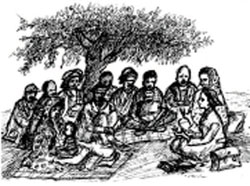
18.6.1 Who needs to know?
From your general knowledge, who do you think you should target to improve awareness about mental health and mental illness?
You could make a special effort to target the following people: people with mental illness and their families, community leaders, religious leaders, traditional healers, other health professionals, traditional birth attendants, teachers, and the police. In fact, every contact you make with a member of your community is an opportunity to improve awareness about mental health and illness.
18.6.2 How do I raise awareness within the community?
When you arrange an awareness-raising meeting in your community, a useful approach could be to find someone who has had successful treatment for mental illness and see if they would be willing to tell their story in public. The photographs in Figure 18.4 and Figure 18.5 give you some ideas for raising awareness on specific issues facing people with mental illness.
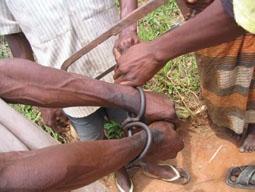
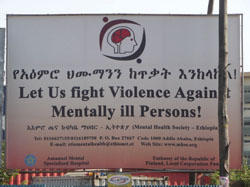
Guided Activity 18.1 Awareness-raising.
Table 18.2 gives a structure for an awareness-raising meeting in your community. Some of the boxes have been completed to get you started and others have been left empty for your own suggestions. Think of what you would say in each part of the meeting, and complete the empty boxes. Write about your experience of trying this technique in your Study Diary and discuss it with your Tutor at the next Study Support Meeting.
| Structure | Examples of what you might say |
|---|---|
Introduce the topic | ‘Today I am going to tell you about the important topic of mental illness’ |
Find out what people already know | ‘Is mental illness a problem in your community?’ ‘What causes of mental illness do you know about?’ |
Explain why mental illness is important | ‘Mental illness is common and causes a lot of suffering’ ‘Anybody can be affected by mental illness during their life’ ‘Mental illness stops a person from living a full life’ ‘People with mental illness are more likely to have poor health and die young’ |
Explain about the different types of mental illness | |
Explain how people can reduce their risk of developing mental illness (primary prevention) | |
Explain why it is important to identify people with mental illness (secondary prevention) | ‘Mental illness can be treated in a health facility, just like a physical illness’ ‘The earlier that treatment is started, the quicker and better the person will recover’ |
Discuss the treatments for mental illness (tertiary prevention) | ‘People with mental illness need to continue with their medication, even if they also have traditional treatments’ ‘Some traditional remedies can be harmful e.g. beating’ ‘As well as medication, people with mental illness need care and support from people around them’ ‘If the person has treatment then they don’t need to be chained up at home’ |
Explain about the negative effect of stigma, discrimination or abuse (secondary and tertiary prevention) | |
Explain how the community can help (secondary and tertiary prevention) | ‘You can help to encourage people with mental illness to go to a health facility and take medication’ ‘You can help by being a friend to the person with mental illness – make them feel included in community life’ ‘You can help by supporting the family of the mentally ill person’ |
In the last study session in this Module you will learn about disability and community rehabilitation.
Summary of Study Session 18
In Study Session 18, you have learned that:
- An important part of mental health promotion and prevention is raising awareness in the community.
- Telling people about the links between child abuse or violence against women and mental illness in adulthood can help to motivate the community to try to stop these practices.
- Khat, alcohol and cannabis are not always harmless and the community can help to encourage responsible use of these substances.
- By encouraging people to use helpful coping strategies for life’s problems, you can help to reduce the risk of mental illness.
- Screening for mental illness should be a routine part of your work. Detecting illness early can mean someone gets treatment and gets better more quickly.
- Suicide prevention is focused on making sure people get treatment for mental illness and helping to support those who attempt suicide.
- People with mental illness are at higher risk of many physical health problems and so need special attention from health workers.
- You can give helpful advice to people with mental illness, their families and communities in order to reduce the disability suffered.
- 9 Tackling stigma against mentally ill people can greatly improve their quality of life.
Self-Assessment Questions (SAQs) for Study Session 18
Now you have completed this study session, you can assess how well you have achieved its Learning Outcomes by answering these questions. Write your answer in your Study Diary and discuss them with your Tutor at the next Study Support Meeting. You can check your answers with the Notes on the Self-Assessment Questions at the end of the Module.
SAQ 18.1 (tests Learning Outcomes 18.1, 18.2 and 18.3)
You decide to run an awareness-raising campaign on how to stay mentally healthy.
- a.Is this primary, secondary or tertiary prevention?
- b.Who would you target?
- c.What would your main messages be?
Answer
- a.Awareness raising about how to stay mentally healthy is an example of primary prevention/mental health promotion. That is because you are targeting people who don’t have mental illness in order to prevent them from developing mental illness.
- b.The decision on who to target depends on the priorities in your local area. You could decide to target the community in general, or specific groups within the population, e.g. school children, women attending for antenatal care, students, health workers or others.
- c.The main awareness-raising messages you choose will depend on the group that you are trying to target. For example, if you were planning to target the general community then you could talk about any of the following areas: the importance of (1) a happy, healthy childhood; (2) reducing the exposure to violence; (3) reducing the use of alcohol, khat and other substances; (4) using helpful coping strategies to deal with life’s problems, and/or (5) reducing the risk of children developing intellectual impairments.
SAQ 18.2 (tests Learning Outcome 18.4)
How could you screen for mental illness, violence and substance misuse in women who come to you for antenatal care?
Answer
When women attend for antenatal care, it provides a good opportunity to screen for mental illness, substance abuse and exposure to violence. As you learned in Study Session 16, pregnant women are commonly victims of intimate partner violence. Also, as well as causing suffering for the woman, mental illness and substance abuse can affect the unborn child. This makes detection even more important. Look back at the relevant Study Sessions to remind yourself how to screen for psychosis (Study Session 13), depression (Study Session 12), substance misuse (Study Session 14) and violence (Study Session 16).
SAQ 18.3 (tests Learning Outcome 18.5)
List three things that you could do to help prevent suicide in your community.
Answer
Some of the ways that you could try to prevent suicide in your community are as follows:
- Making sure that you know how to assess a person’s suicide risk (you can remind yourself by looking back at Study Session 10).
- Helping to support people who have attempted suicide.
- Helping people with mental illness or a substance misuse problem to get the treatment they need.
- Encouraging people to use helpful coping strategies if they have a problem.
SAQ 18.4 (tests Learning Outcomes 18.6 and 18.7)
A patient in your kebele who is suffering from psychosis develops a persistent cough. When they attend the health centre the nurse prescribes diazepam to treat the psychosis, but no examination of the cough problems takes place. What could you do?
Answer
People with mental illness often don’t get the same quality of care when they attend health facilities as people who don’t have a mental illness. Sometimes this happens because the mental illness stops the person expressing themselves clearly. But it can also happen if health professionals discriminate against people with mental illness.
Health professionals may hold the same negative attitudes towards the mentally ill as many in the community. In this case, the person needs to have a proper assessment to find the cause of their persistent cough. You could help by:
- Going with the person to the health facility, helping them to express themselves clearly and helping them to remember the advice given to them.
- Exploring the health professional’s attitude towards people with mental illness. They may believe that people with mental illness are dangerous or that they are unreliable. Because of such beliefs, the health professional may not take the person’s physical complaints seriously. If such beliefs are present then you can explain to the health professionals that people with mental illness are at high risk of physical health problems and need the same level of care as anybody else.